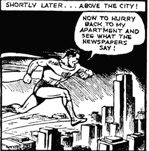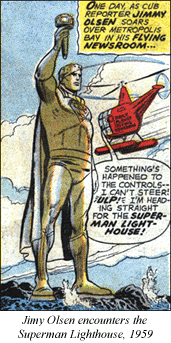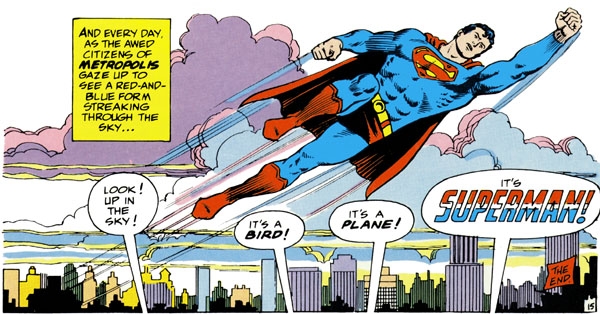Metropolis
Metropolis
The resident city of Superman and the scene of the vast majority of his adventures. Metropolis as it is described in the texts is modeled after, and fully intended to represent, the city of New York.
In the earliest texts of the Superman chronicles, Superman's home city remains unidentified. Action Comics No. 11 explicitly identifies it as Cleveland, Ohio (Apr 1939), but Action Comics No. 13 contradicts this by placing Superman's resident city within close proximity to the Sing Sing state prison, in Ossining, New York (Jun 1939). In late 1939, the name Metropolis appears in the chronicles for the first time (Act No. 16, Sep 1939), and the city is situated definitely in New York State (S No. 2/2, Fall 1939: "Superman Champions Universal Peace!").
The evidence identifying Metropolis with the city of New York is overwhelming, despite the appearance of an occasional text identifying Metropolis and New York as two separate cities (Act No. 311, Apr 1964: "Superman, King of Earth!"; and others). Situated in the eastern United States (WF No. 46, Jun/Jul 1950: "The Seven Crimes of Mister 7!"), more specifically, in New York State (S No. 212, Fall 1939: "Superman Champions Universal Peace!"), only a short trip by train from New Haven, Connecticut (S No. 25/2, Nov/Dec 1943: "I Sustain the Wings!"), Metropolis is a major seaport with a large waterfront (Act No. 187 , Dec 1953: "Superman's New Super Powers!"; and many others) whose population, in 1951, was 6,004,119 (S No. 71/2, Jul/Aug 1951: "The Anti-Superman Club!"). The city proper stands on Metropolis Island, which was sold to white settlers by the Indians "over three hundred years ago" (Act No. 148, Sep 1950: "Superman, Indian Chief!"). The United Nations is headquartered in Metropolis (Act No. 311, Apr 1964: "Superman, King of Earth!"; and others), and the world-famed Statue of Liberty stands vigilant in Metropolis Harbor (Act No. 143, Apr 1950: "The Bride of Superman!"; see also Act No. 146, Jul 1950: "The Statues That Came to Life!"). Metropolis's magnificent skyline is world famous (S No. 26/1, Jan/Feb 1944: "The Super Stunt Man!"; and others). Although one text describes Metropolis, somewhat ambiguously, as "a typical American city representative of the rest of the nation" (S No. 18/1, Sep/Oct 1942: "The Conquest of a City"), others describe it as a "great city" (Act No. 30, Nov 1940; S No. 68/1, Jan/Feb 1951: "The Six Elements of Crime!"), "America's greatest city" (Act No. 103, Dec 1946: "The Road to Happiness!"), and "the greatest city in the world" (S No. 64/2, May/Jun 1950: "The Isle of Giant Insects!").
Metropolis's mightiest skyscraper is variously referred to as the Emperor Building (Act No. 80, Jan 1945: "Mr. Mxyzptlk Returns!"; Act No. 102, Nov 1946: "Mr. Mxyzptlk and His Wonderful Lamp!"), the Metropolis State Building (Act No. 204, May 1955: "The Man Who Could Make Superman Do Anything!"), the Monarch State Building (S No. 70/2, May/Jun 1951: "The Life of Superman!"; S No. 75/2, Mar/Apr 1952: "Superman--Thrill Salesman!"), and the State Skyscraper (Act No. 162, Nov 1951: "It!"), but, whatever its name, it is the tallest building in Metropolis and the central feature of its famous skyline.
Other places of interest in Metropolis include the Metropolis Museum of Natural History (Act No. 44, Jan 1942; see also Act No. 181, Jun 1953: "The New Superman"), the Metropolis Planetarium (S No. 91/1, Aug 1954: "The Superman Stamp!"), the Metropolitan Museum (S No. 106/2, Jul 1956: "The Thefts of Clark Kent"), the Wireless City movie theater (S No. 25/4, Nov/Dec 1943: "Hi-Jack--Jackal of Crime!"), the Halldorf Hotel (S No. 36/2, Sep/Oct 1945: "Glory for Gloria!"), and the Metropolis Public Library, whose entranceway is adorned by a pair of stone lions (Act No. 146, Jul 1950: "The Statues That Came to Life!"; see also WF No. 28, May/Jun 1947: "Superman's Super-Self!"). Metropolis's lavish shops include Lacey's Department Store (S No. 21/3, Mar/Apr 1943: "The Robber Knight"), Stacy's Department Store (S No. 31/1, Nov/Dec 1944: "Tune Up for Crime!"; and others), and Spiffany's Jewelry Store (S No. 52/1, May/Jun 1948: "Preview of Plunder").
Metropolis University is located in Metropolis (S No. 125/2, Nov 1958: "Clark Kent's College Days"; and others), as is the Superman Museum (S No. 150/3, Jan 1962: "When the World Forgot Superman!"; and others), and the Daily Planet Building, home of the Daily Planet (Act No. 36, May 1941; and others), Metropolis's "leading newspaper" (S No. 6/1, Sep/Oct 1940; and others).
Metropolis's famous neighborhoods include Queens (S No. 70/1, May/Jun 1951: "Lois Lane Meets Annie Oakley!"); Chinatown (S No. 54/2, Sep/Oct 1948: "The Secret of the Chinese Dragon!"; Act No. 231, Aug 1957: "Sir Jimmy Olsen, Knight of Metropolis"); Little Bohemia, "the famed artist's section of Metropolis" (Act No. 78, Nov 1944: "The Chef of Bohemia!"); the midtown area (S No. 27/3, Mar/Apr 1944: "Robbers' Roost!"); Fifth Avenue (S No. 24/3, Sep/Oct 1943: "Surprise for Superman!"); the financial district (WF No. 12, Win 1943: "The Man Who Stole a Reputation!"; and others); the slum area known as Roaring Kitchen (S No. 22/2, May/Jun 1943: "The Luck of O'Grady"); the waterfront district (Act No. 187, Dec 1953: "Superman's New Super Powers!"; and others); and Planet Square, the so-called "crossroads of the world" (Act No. 77, Oct 1944: "The Headline Hoax!"; and others), located in the heart of Metropolis's Great White Way (Act No. 112, Sep 1947: "The Cross-Country Chess Crimes!"; see also S No. 22/3, May/Jun 1943: "The Great ABC Panic!").
For recreation and relaxation there is Metropolis Park (WF No. 68, Jan/Feb 1954: "The Menace from the Stars!"; and others), where city dwellers and tourists alike can take a boat ride on a quiet lake (S No. 22/4, May/Jun 1943: "A Modern Robin Hood!"), jog around the reservoir (WF No. 37, Nov/Dec 1948: "The Superman Story!"), or travel along its roadways by car (S No. 22/4, May/Jun 1943: "A Modern Robin Hood!") or horse-drawn carriage (Act No. 163, Dec 1951: "The Girl of Tomorrow"). The Superman Museum is located in Metropolis Park (S No. 150/3, Jan 1962: "When the World Forgot Superman!"), along with "a colossal steel statue of Superman—erected by a grateful city" (WF No. 28, May/Jun 1947: "Superman's Super-Self!"; and others). The inscription on the statue's pedestal reads, "Superman, Champion of Metropolis" (Act No. 249, Feb 1959: "The Kryptonite Man!").
Metropolis features an elaborate transportation system, including a network of elevated (Act No. 20, Jan 1940; and others) and subterranean subways (S No. 17/1, Jul/Aug 1942: "Man or Superman?"; and many others), ferryboats (S No. 71/3, Jul/Aug 1951: "The Man Who Stole the Oceans!"), bridges (S No. 18/1, Sep/Oct 1942: "The Conquest of a City"; and others), and vehicular tunnels (S No.52/1, May/Jun 1948: "Preview of Plunder"; and others). Streetcars were commonplace in Metropolis in 1941 (WF No. 4, Win 1941: "The Case of the Crime Crusade") and apparently survived even into the early 1960s (S No. 151/2, Feb 1962: "The Man Who Trained Supermen!"). Parties of tourists circle the city aboard special excursion vessels (Act No. 146, Jul 1950: "The Statues That Came to Life!"), or romp in the surf off Metropolis's popular public beaches (S No. 48/1, Sep/Oct 1947: "The Man Who Stole the Sun!"; S No. 19/3, Nov/Dec 1942). Specially honored guests are treated to "Metropolis' famed ticker-tape reception" (Act No. 165, Feb 1952: "The Man Who Conquered Superman!"), such as that accorded King Harrupp II upon his arrival in Metropolis in January-February 1951 (S No. 68/2: "Lois Lane's Royal Romance!").
The gateway to Metropolis is Metropolis Harbor (WF No. 20, Win 1945: "The Toyman: Super-Scientist!"; and many others), the point of arrival and departure for ocean liners (S No. 63/1, Mar/Apr 1950: "Achilles versus Superman!"; and others), freighters (WF No. 20, Win 1945: "The Toyman: Super-Scientist!"; and others), and other vessels (WF No. 37, Nov/Dec 1948: "The Superman Story!"; and others). Visitors sailing into Metropolis Harbor are greeted by the world-famed Statue of Liberty (Act No. 143, Apr 1950: "The Bride of Superman!"; see also Act No. 146, Jul 1950: "The Statues That Came to Life!") and by a gigantic statue of Superman standing astride the harbor like the legendary Colossus of Rhodes (WF No. 23, Jul/Aug 1946: "The Colossus of Metropolis!"). Metropolis waterways mentioned in the chronicles include the Metropolis River (WF No. 49, Dec/Jan 1950-1951: "The Men Who Shot Superman!") and Metropolis Bay (S No.81/2, Mar/Apr 1953: "20,000 Leagues Under the Sea with Superman"; and others) which is home to the gigantic Superman Lighthouse, holding its light aloft in one hand (SPJO No. 37, Jun 1959: "Superman's Super-Rival!").
Metropolis's "most famous inhabitant" is indisputably Superman (S No.26/4, Jan/Feb 1944: "The Quicksilver Kid!"; and others), and it is for him that the city has reserved its greatest honors. Superman Day has been celebrated in Metropolis on at least two separate occasions (S No. 157/3, Nov 1962: "Superman's Day of Doom!"; Act No. 328, Sep 1965: "Superman's Hands of Doom!"), and the famed Superman Museum houses an extensive collection of Superman memorabilia (S No. 150/3, Jan 1962: "When the World Forgot Superman!"; and others). Superman was awarded the city's Outstanding Citizen Award for 1954 "in honor of [his] conspicuous efforts to improve Metropolis" (S No. 93/2, Nov 1954: "Jimmy Olsen's Double!"). For at least four years during the 1950s, the Metropolis Police Department awarded an annual Superman Medal "to the person whose heroism ...helped Superman the most" during the preceding year. Clark Kent, the man who is secretly Superman, is awarded the Superman Medal in August 1955 (Act No. 207: "The Four Superman Medals!").
Statues and other artistic tributes to Superman abound in Metropolis, including the statue of Superman in the Metropolis Hall of Fame (Act No. 297, Feb 1963: "The Man Who Betrayed Superman's Identity!"), the "colossal steel statue of Superman" in Metropolis Park (WF No. 28, May/Jun 1947: "Superman's Super-Self"; and others), the monumental statue of Superman towering over Metropolis Harbor (WF No. 23, Jul/Aug 1946: "The Colossus of Metropolis!"), the Superman Lighthouse in Metropolis Bay (SPJO No. 37, Jun 1959: "Superman's Super-Rival!"), and the marble statue of Superman unveiled in Planet Square in January-February 1946 (S No. 38/3: "The Man of Stone!"; S No. 69/1, Mar/Apr 1951: "The Prankster's Apprentice!").
Midvale, the adopted home town of Linda Lee Danvers, the pretty blonde teenager who is secretly Supergirl, is a suburb of Metropolis. So is the town of Highville, which Superman visits in January 1957 (S No. 110/2: "The Mystery of Superman!"). Metrodale, another Metropolis suburb, is destroyed by Rolf Zimba's Gold Badge Organization in July-August 1941 (S No. 11/1). Bizarro City, the capital of the planet Htrae (S No. 140, Oct 1960: pts. I-III—"The Son of Bizarro!"; "The 'Orphan' Bizarro!"; 'The Bizarro Supergirl!"), is "a crude copy of Metropolis" which looks like something a mad architect would design!" (Act No. 263, Apr 1960: "The World of Bizarros!").
Like all major cities, Metropolis has areas that are home to those who don't enjoy economic advantage. By the 1970s, the chronicles document two areas of the city that are relatively impoverished and preyed upon by criminal elements such as Intergang and The 100. These neighborhoods are Little Africa and "Suicide Slum." Other than Superman, the Thorn and Black Lightning work to oppose villainy in those locations.


